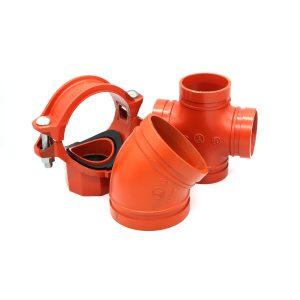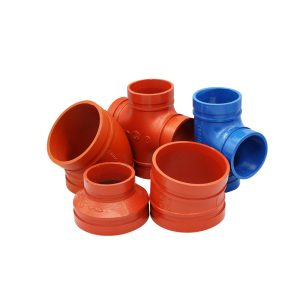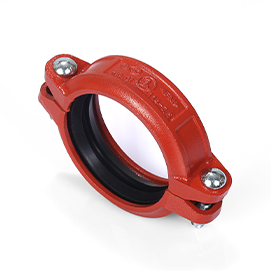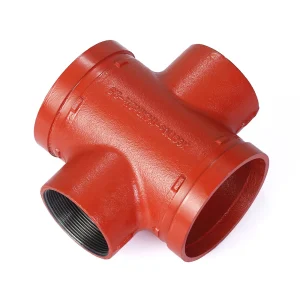
Hey there, if you’re knee-deep in piping systems—whether it’s keeping buildings cool in the summer heat, safeguarding against fires, or handling tough industrial flows—you know picking the right mechanical tee isn’t just a checkbox. It’s what keeps everything running smooth without leaks or breakdowns. I’ve been around the block with these setups, and let me tell you, getting the sizing and specs spot-on can save you headaches down the line. In this post, we’ll break it down step by step, drawing from real-world installs and solid data. Stick around; by the end, you’ll feel more confident tackling your next project.
Understanding Mechanical Tees: The Basics
First off, what’s a mechanical tee anyway? Picture this: you’re routing pipes in a busy HVAC system, and you need to branch off without welding or fussing with threads that might fail under pressure. A mechanical tee is basically a grooved fitting that lets you connect a branch line to the main run quickly. It’s got that tee shape—hence the name—but with grooves that lock in with couplings for a tight seal.
These aren’t your average fittings. They’re built tough for high-stakes environments. Take fire protection systems, for instance. You can’t afford a weak link when sprinklers need to kick in. Or in industrial apps, where chemicals or heavy flows are involved—yeah, reliability is key.
Types of Mechanical Tees and When to Use Them
Not all mechanical tees are created equal. You’ve got threaded ones, which are handy for smaller branches where you might tie into valves or gauges. From what I’ve seen in the field, threaded mechanical tees shine in retrofits because they’re easier to install without shutting down the whole system.
For example, in a recent warehouse upgrade I heard about, the crew swapped in threaded tees to add monitoring points. No major downtime, and it held up under varying pressures. Sizes typically run from 1 inch up to 10 inches, or DN25 to DN250 if you’re metric-minded. That’s broad enough for most jobs, but always double-check your pipe diameters.
On the flip side, if you’re dealing with larger mains, grooved mechanical tees without threads might be better for straight-up branching. They integrate seamlessly with other grooved components, like elbows or crosses.
Key Factors in Sizing Your Mechanical Tee
Sizing isn’t guesswork. Get it wrong, and you could end up with flow restrictions or even structural failures. Start with your pipe sizes—main run and branch. The tee has to match both to avoid bottlenecks.
Here’s a quick table to visualize common sizing ranges based on standard offerings:
| Nominal Size (Inches) | DN Equivalent | Typical Branch Sizes Available |
| 1 – 2 | DN25 – DN50 | 1/2″ – 1″ |
| 3 – 6 | DN80 – DN150 | 1″ – 3″ |
| 8 – 10 | DN200 – DN250 | 2″ – 4″ |
These are pulled from proven products that handle pressures up to 300 PSI or more, depending on the config. But hey, don’t just take my word—measure your pipes twice. Flow rates matter too. If your HVAC system’s pushing high volumes, undersizing the branch could spike pressure drops, leading to inefficient cooling. I’ve seen that happen in office buildings where AC units struggled because someone skimped on tee sizes.
Temperature’s another biggie. Most tees handle -20°F to +180°F, which covers chilly winters to steamy industrial lines. But if your app swings wider, you might need custom specs. And materials? Ductile iron like ASTM A536 Grade 65-45-12 is standard—tough, corrosion-resistant, and meets codes like ISO6182 or AWWA C606.
Pressure Ratings and Flow Dynamics
Pressure ratings tie directly to sizing. For fire protection, you want tees rated for at least 225 PSI to match system demands. In HVAC, it might be lower, around 150-200 PSI, but always factor in surges.
Think about flow dynamics. A too-small tee creates turbulence, which erodes pipes over time. Use Reynolds numbers if you’re into the math—anything over 4,000 means turbulent flow, common in these systems. Better to oversize slightly for longevity, though that bumps costs a tad.
Specifying for Specific Applications
Now, let’s get application-specific. Each field has its quirks.
HVAC Systems: Efficiency Meets Durability
In HVAC, mechanical tees branch off for zoning or adding coils. Specify for low-vibration installs to keep noise down—nobody wants a rattling system in a quiet office. Go for tees with EPDM gaskets for that leak-proof vibe under varying temps.
Real talk: In a hotel retrofit I know of, they used 4-inch tees for chilled water lines. Held steady at 100 PSI, no leaks after two years. Key spec? Ensure compatibility with grooved pipes to cut install time by half compared to flanged options.
Fire Protection: Safety First
Fire systems demand zero compromises. Mechanical tees here connect sprinklers or standpipes. Look for UL-listed or FM-approved fittings to pass inspections.
Sizing tip: Branch sizes should match sprinkler heads—usually 1-inch for standard coverage. And temperature range? That -20°F to +180°F covers frozen warehouses to hot attics. One fire chief I chatted with swore by these for quick expansions in older buildings, avoiding welds that could weaken pipes.
Industrial Applications: Handling the Tough Stuff
Industrials throw curveballs like abrasive slurries or corrosive fluids. Specify tees with enhanced coatings if needed. Sizes up to 10 inches handle big flows, like in petrochemical plants.
Example: A manufacturing plant used 6-inch tees for coolant lines. Withstood 250 PSI and temps up to 150°F without a hitch. Pro tip: Factor in expansion—pipes grow with heat, so flexible tees prevent cracks.
Oh, and a side note: Ever notice how these fittings remind you of Lego blocks? Snap together, build complex systems. Kinda fun, if you’re into that.
Standards and Compliance: Don’t Skip This
Always spec to standards. ASTM A536 for materials ensures ductility—bends without breaking. Design codes like GB 5135.11 guarantee interoperability.
Compliance isn’t bureaucracy; it’s peace of mind. In the U.S., AWWA C606 is gold for water systems. Miss it, and your insurance might balk.
Bullet points for quick specs checklist:
- Material: Ductile iron (Grade 65-45-12 or 65-45-15)
- Pressure: Up to 363 PSI for high-demand apps
- Temp Range: -20°F to +180°F (-29°C to +82°C)
- Sizes: 1″ to 10″ (DN25-DN250)
- Standards: ISO6182, AWWA C606, GB 5135.11
Introducing Vicast: Your Go-To Mechanical Tee Supplier
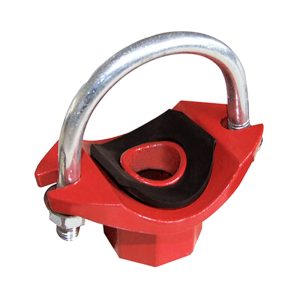
When it comes to sourcing these tees, Vicast stands out as a reliable player in grooved pipe fittings. Based out of China but with a global reach, they’ve been crafting high-quality components like the XGQT15S mechanical tee threaded for years. What sets them apart? Their focus on precision engineering and materials that meet top standards, all while keeping installs straightforward. Whether you’re scaling up a fire system or tweaking an industrial line, Vicast’s lineup offers that blend of durability and ease—think robust ductile iron builds that lock in without fuss. Check their site for more on how they support projects from HVAC to heavy industry.
Conclusion
Wrapping this up, sizing and specifying the right mechanical tee boils down to knowing your app inside out—pipes, pressures, temps, and all. Get it right, and your systems run like clockwork, saving time and bucks long-term. It’s not rocket science, but a little upfront thought goes a long way. If you’re gearing up for a project, start with measurements and standards; the rest falls into place.
FAQs
What factors should I consider when sizing a mechanical tee for HVAC applications?
When sizing a mechanical tee for HVAC, focus on pipe diameters, flow rates, and pressure drops. For instance, ensure the branch size matches your zoning needs—say, 2-inch for medium flows—to avoid inefficiencies. Also, check temp ranges like -20°F to +180°F to handle seasonal swings.
How do I specify the right mechanical tee for fire protection systems?
For fire protection, prioritize pressure ratings (at least 225 PSI) and compliance with standards like AWWA C606. Branch sizes should align with sprinklers, typically 1-inch, and opt for ductile iron materials for that extra toughness against impacts.
Can mechanical tees handle industrial applications with corrosive fluids?
Yeah, they can, but specify coatings or materials like ASTM A395 Grade 65-45-15 for better resistance. Sizes up to 10 inches work for heavy flows, and always test for your specific chemicals to dodge surprises.
What’s the typical temperature range for a mechanical tee in industrial use?
Most handle -20°F to +180°F, which covers a lot of ground from cold storage to heated processes. If your setup pushes extremes, consult suppliers like Vicast for custom options.
Why is material standard important when specifying a mechanical tee?
It ensures durability—think ASTM A536 for ductility that withstands vibrations. Skimp here, and you risk failures; stick to it, and your HVAC, fire protection, or industrial system stays solid for years.

